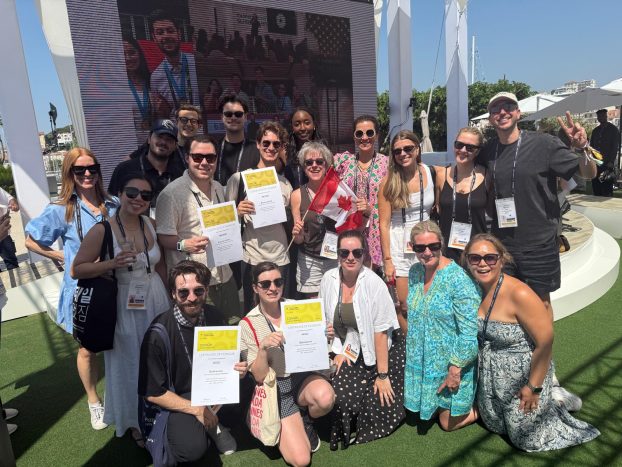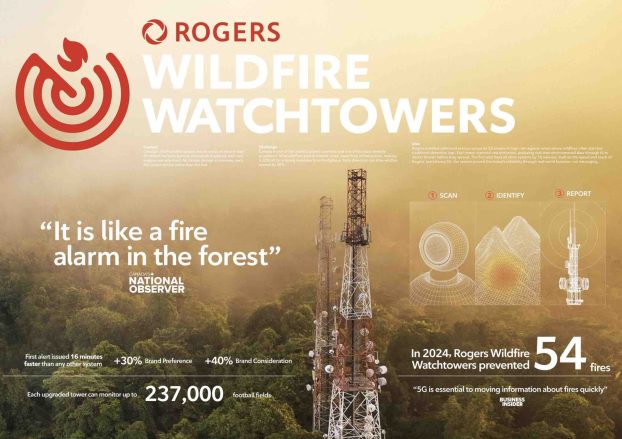Just west of Vancouver’s festive Granville Island, snuggled among the Ferrari, Porsche and Aston Martin dealerships and a specialty food store with more flavours of mustard than words in this paragraph, there is a large-windowed, two-storey grey building. Its ground floor sports a decor that has clearly ceded free rein to its designers’ inner children. A life-size caveman on a cell phone, a giant Shreddies box and a Bugs Bunny cut-out in a wall of faux brick punctuate a warren of doorless offices blazing with day-glo greens, blues and ochres. Cheery production personnel ply their Macs on a platform a metre above floor level in a fan-cooled area referred to as the ‘Techno Lounge.’ A fridge bulges with Pepsi, juice and several brands of beer.
Spiritually and geographically it’s miles from the original eponymous Big House, a former Victorian mansion on Vancouver’s shady Downtown East Side where the three partners of Big House Communications – Joan Fedoruk, Lorne Craig and Ken Fedoruk – opened their ad agency in 1989 before weighing anchor a year later on the building’s ghost and a stabbing by a psychotic neighbour that put Ken in hospital. The design is immediately engaging – a heartbeat from naive, some might say – but well considered. The lack of resemblance to a legal or accounting firm is no accident.
‘We wanted a creative environment that was fresh, colourful and inspiring all year long, not just in the summer when it’s sunny,’ says red-headed Joan Fedoruk, artist-turned-account director turned CEO after drawing the shortest straw in a position-selection process the partners held before incorporating (her business card says ‘Big Wig’). ‘And not just for us, but for visiting clients and suppliers.’
‘The office set-up has no physical barriers,’ says Ken Fedoruk, who looks more like a rock crusher salesman than the artist who crafted a delicate painting of a mother whale and calf hanging on an inside wall. Or the co-creative director he is. ‘We didn’t want little fiefdoms.’
‘Because of our size and open plan, everyone has a feeling about what’s going on,’ says the goateed and pony-tailed Lorne Craig. ‘If somebody phones, everyone knows. It’s an approach we are trying to retain as we get bigger and more compartmentalized. Being aware of what’s happening around them means everyone can feel free to contribute ideas or suggestions even on projects they’re not working on.’
Big House Rule #3:
Always make life fun.
Behind the barn-sized plexiglass door of the boardroom, an adjustable table with triangular sections on wheels reconfigures in Euclidian fashion for meetings big or small. The room can be tailored for shows or presentations, or as a staff conference area.
Space under the Techno Lounge is used for storage, while an open ‘pit’ area below is used for Christmas gift exchanges, occasional client meetings or informal gatherings like the impromptu party after Big House bagged the 1998 (B.C. advertising) Lotus Award for Best Web Design.
Ample for most occasions, the 3500-foot floorspace strained its last belt hole on a warm Thursday evening last October. To thank suppliers and clients for being a part of the agency’s success, to reintroduce themselves to the Vancouver advertising community and to prove that they are major-league partiers, Big House threw a 10th anniversary gala. The 287 guests were treated to an open bar with two bartenders, a gala buffet of hors d’oeuvres, hot appetizers, multiple salads, raw oysters and rich desserts, all furnished by Vancouver’s upscale Lazy Gourmet. Most left with fond memories and a free T-shirt wrapped in a metallic ribbon whose colour designated size.
Many also carried away a 40-page, Cerlox-bound company promo booklet bearing the apparent title of ‘The Rules’ (which turns out to be ‘There are no Rules’ once you open it). The Big House rules were developed during a professionally facilitated company retreat, and still serve as the firm’s mission statement. Example: ‘The huddle includes everyone.’ Or how about: ‘Measure twice. Cut once.’ Among its many illustrations and photographs (many by staff) is a scratch ‘n’ sniff skunk which helps illustrates Big House rule #11: ‘Open your mind before you open your mouth.’ Scratching under the skunk’s tail releases not a noxious mammalian emission, but the lovely scent of roses.
Big House was born with neither the silver spoon of a lucrative account in its mouth, nor the swagger of a hot creative reputation buttressed by bagsful of prestigious awards. Agency experience among the young trio was scattered; Craig had served two years at the late McKim Advertising, Ken had interned at JWT and Joan had freelanced at three Vancouver shops. But the three pooled their eclectic experiences, their considerable design and drawing talent and their Alberta College of Art diplomas – and perhaps most important, the blind ambition that often shades 20-somethings from the world’s withering realities – to form a freelance venture that quickly matured into an incorporated agency.
Although the concept of creative people running a business still beggars some imaginations, the two Fedoruks (married since 1992) and Craig outlasted many a Late Night with Letterman to cultivate a solid from-the-ground-up approach. While Lorne and Ken learned everything they could about the still-new alchemy of computer design and production, Joan embraced her client-side orientation by taking courses in media buying, accounting and business writing while also working toward the CAAP certification she now holds.
The process spawned an agency that absorbed the business of advertising and the business of business at the same time, producing a combination of hard-knocks learning, formal training and bottom-line savvy – engendered by such management chores as selecting benefit packages and dealing with landlords – that gives Big House a degree of client empathy that few agency-employed creatives can match, says Joan.
‘Our clients appreciate that we’re creative people and business people,’ she says. ‘They’re not getting creative done by people who don’t know a thing about the bottom line.’
Big House also developed a flat management style, where the 12 full-time employees tend to steward assigned tasks from start to finish. An unscientific monitoring of laughter through the hallways points to the presence of more than the usual amount of job satisfaction.
Big House Rule #9:
Be a captain. Chart your own course.
Being self-taught also makes the partners choosy.
‘We’re not the ideal company for every advertiser,’ says Joan. ‘And we’re certainly not interested in every company with a $2 million account. But the $2 million account that’s looking for a unique way to promote their product or service and that likes our style and approach can definitely benefit from an association with us.’
‘We go after client personality types rather than product or service niches,’ says Craig. ‘We want to be the agency people turn to when they want something a little more on the edge, with a little more humour, whether they’re selling candy or caskets.’
‘You have to like the guy and be comfortable around him and invite him to a BBQ and play baseball with him,’ says Ken.
Craig cites the example of a client the agency resigned because it wasn’t using the same strategic reasoning to justify creative input that Big House says it uses.
‘We got personal creative feedback instead of business creative feedback, and that’s not good enough. We’re forced to justify our creative all the time, and that’s the way it should be. For clients to impose creative just because they feel like it is neither fair nor good business.’
Big House Rule #4:
Every customer is a Big customer.
Big House has been instrumental in successfully rebranding myriad clients. Whistler Mountain went from a money-losing operation to emerging as North America’s number one ski resort – while making itself a viable buyout for Intrawest, says Fedoruk. Two prominent Vancouver prepress/printing facilities which merged turned to Big House to develop their name – AKA Rhino – and their new image. The stocks of three of Big House’s publicly-traded clients have steadily outperformed the TSE and Dow Jones indices.
When Intrawest had a mega-resort to sell – the Lone Eagle in Keystone, Colorado – it asked Big House to design and produce the direct mail lead-generation campaign, the brochure fulfillment package, the website, and even the wallboard displays in the sales centres. On the launch date, Lone Eagle sold 90 percent of the project in a wallet-wrenching 1.5 hours. At an average unit price per unit of $800,000 U.S., that worked out to $38.5 million worth of real estate in 1.5 hours.
Humour is a frequent Big House strategy. A cheeky Christmas print ad for a testicle-friendly bike seat for men from Big House client Bicycle Sports Pacific nearly cleared the item from store shelves in 48 hours. The headline: ‘Keep his bells a-jingling.’
As their main strength, the partners point to strategic creative and Web proficiency based on an integrated, technically savvy multi-platform marketing approach.
‘It all started in ’94 at a writers’ retreat on interactive technology on Granville Island,’ says Craig. ‘As a small, creative-driven company, we were able to follow our interest instantly. We sat down and said, ‘Yeah, this is where this thing is gonna go.’
‘We didn’t get a website up till ’96, but we were still ahead of other agencies because we didn’t have layers of management to paralyze us. We’ve always recognized the importance of content; good writing, imagery and entertainment value are the same things we put into our ads. Our web advertising has always been totally integrated with the traditional media.’
Craig says Big House is closing the loop between what people experience at a typical sale or service outlet and what they’re driven to see and do on-line. For Granville Island-based retailer Edie’s Hats, an integrated campaign includes e-commerce website, in-store counter cards and opt-in e-mail – permission advertising which results in monthly mailings to customers with incentives to come in for fittings or subscribe to fashion magazines at reduced prices.
Big House Rule #5:
Believe in profit and success for everyone.
‘With the Intrawest project, we already had 80 percent of the circle in place,’ says Craig. ‘Adding the Internet component gave sales people another tool to use over the phone (by referring prospects to the site for more information), and allowed people to sign up for sales exhibitions and to get in line to visit the condos under a priority reservation system.’
Says Ken Fedoruk: ‘We used to have to sell people on the idea of having a website. Now we’re selling websites and upselling more traditional marketing approaches to create an integrated strategy. It will be an essential part of marketing in the future.’
‘Our website isn’t just a sign on the digital highway,’ says Craig. ‘It’s actually part of our business systems. We’ve had clients hire us just because of our website.’
In late January, Science World, an entertainment attraction at the foot of False Creek near downtown, awarded Big House its $800,000 account after talking to a number of Vancouver agencies, large and small.
‘Their technical literacy and their emphasis on the importance of the web and internet as part of an integrated marketing strategy are very appealing to us,’ says Ray Lord, Director of Marketing and Communications.
‘Also, Big House is a fun group, and Science World is about fun. Their spirited, creative approach is a direct reflection of how we work here at Science World.’
Big House’s computer literacy has practical benefits, too. ‘The Big House online proofing station is unique among Vancouver agencies, and built right into our website,’ says Joan Fedoruk.
Although it was created out of a necessity to serve long-distance clients like Calgary-based Pepsi-Cola, she calls it a perfect example of how technology created a USP for Big House.
With Internet outreach there is also opportunity. One international client awarded Big House a $200,000 (U.S.) project based solely on the Big House website and subsequent phone conversations – and never meeting agency personnel.
Big House’s creative zeal stops shy of what Craig calls ‘awardvertising’ – ads done for little or no fees to impress visiting judges at awards shows. The ads have creative merit but sometimes win on false premises, Big House maintains.
‘If it only runs once at 3:00 a.m. in Bugsplat, Saskatchewan, what’s the point?’ echoes Ken. ‘Without strategy, it’s just a cute idea.’
Big House Rule #1:
Think Big!
‘We’re not thinking in little silos where different groups work on different aspects of a single campaign,’ says Joan. ‘The guy who’s designing your brochure or writing your radio campaign is also the guy who’s thinking about how your website is going to work. The focus is always on strong, strategic creative.’
Having a good time doing it is Big House’s winning formula.




























